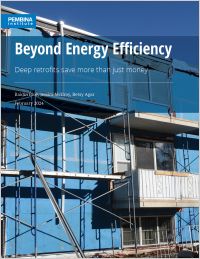
Deep retrofits like this low-rise building development need additional support from the government to increase demand, according to the Pembina Institute Photo: Roberta Franchuk, Pembina Institute
Our new report, “Beyond Energy Efficiency: Deep retrofits save more than just money,” explores the benefits of deep retrofits to Canada’s buildings. We estimate that Canada needs to retrofit 600,000 existing homes and 32 million square metres of existing commercial space each year to reach 2050 net-zero targets.
Deep retrofits are holistic energy efficiency home upgrades that improve occupant health and make housing more affordable by lowering utility bills, achieved through the use of low-carbon materials, new technologies (like heat pumps) and integration with smart electricity grids. While deep retrofits are best known in Canada for reducing energy costs through increased energy efficiency, the new report provides a more comprehensive overview of all the benefits.
Done right, deep retrofits should help Canadians have homes that are:
Affordable: Equitable distribution of deep retrofit benefits to overcome the disproportionate impact of climate events and energy poverty on vulnerable communities.
Low carbon: Implementing energy efficiency measures and fuel switching to reduce operational carbon, and selecting materials that have low embodied carbon.
Climate resilient: Retrofitting to improve resilience in the face of climate-related risks and protect Canadians, especially vulnerable populations.
Healthy: Investing in deep retrofits to mitigate climate-related health risks such as by improving indoor air quality and reducing exposure to extreme temperatures.
Smart grid integrated: Implementing energy efficiency measures, onsite renewable energy generation, and smart controls to transform buildings into grid-integrated energy hubs. "
These valuable non-energy benefits are not usually captured in the payback of a retrofit and so are typically ignored. This means the full value of a retrofit versus the payback of the investment are not generally aligned.
 Our report concludes with several recommendations, such as the need for governments to create targeted policies and support for fuel switching and efficiency improvements for those who are currently facing, or at risk of, energy poverty. We also recommend setting targets for decarbonizing and adapting homes to ready them for increasingly frequent and extreme weather, supporting industry capacity growth and opening workforce opportunities for equity-deserving groups, and more.
Our report concludes with several recommendations, such as the need for governments to create targeted policies and support for fuel switching and efficiency improvements for those who are currently facing, or at risk of, energy poverty. We also recommend setting targets for decarbonizing and adapting homes to ready them for increasingly frequent and extreme weather, supporting industry capacity growth and opening workforce opportunities for equity-deserving groups, and more.
Read the full report: Beyond Energy Efficiency: Deep retrofits save more than just money
Betsy Agar is director of the Pembina Institute's buildings program, based in Vancouver.



